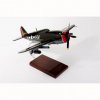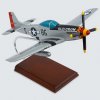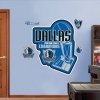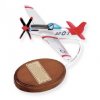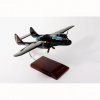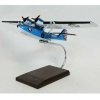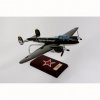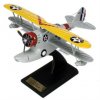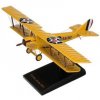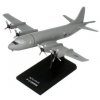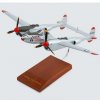"The P-38J Pudgy aircraft was flown by Thomas McGuire and won 38 victories, second to the lightning called “Marge”. The aircraft was developed for the United States Army Air Corps to be one of the American fighter aircrafts during the Second World War. The P-38J Pudgy was designed by Clarence “Kelly” Johnson in response to the Army specification for an aircraft that can reach 20,000 feet in 6 minutes. The P38 had its unique twin booms with forward-mounted engines. It was the only American fighter with twin booms during World War II. It was most used for bombing and reconnaissance missions and in theaters of war such as the Pacific Theater and the China-Burma-India Operations. The P-38 is said to be one of the best American fighter planes of the Second World War. "
Scale: 1/32 scale model
Wing Span: 19.5
Length: 14.25
AP38PUTS
|
"The Curtiss P-40 Warhawk was an American single-engine, single-seat, low-wing, all-metal fighter and ground attack aircraft manufactured by Curtiss-Wright Corporation. In the 1930s and 1940s, the P-40 Warhawk fighter bomber was the last of the famous ""Hawk"" line, and it shared certain design elements with its predecessors, the Hawk and Sparrowhawk. Warhawk was the name the United States Army Air Corps adopted for all models, making it the official name in the United States for all P-40s. It was the third-most numerous US fighter of World War II. An early prototype version of the P-40 was the first American fighter capable of speeds greater than 300 mph. Design work on the aircraft began in 1937, but numerous experimental versions were tested and refined before the first production version of the P40, the Model 81, appeared in May 1940. By September of that year, over 200 had been delivered to the Army Air Corps. 185 more were delivered to the United Kingdom in the fall of 1940, where they were designated the Tomahawk Mk I. P-40s first saw wartime service with the British Commonwealth squadrons of the Desert Air Force in August 1941. The P-40E, also called the ""Kittyhawk"" and ""Tomahawk"" in England and Canada, was a modified version of the earlier P-40 Warhawk. The P-40E had six machine guns and 700 lbs. of external bombs. P-40E was an accurate scale rendition of an actual Flying Tiger aircraft used during World War II, but its realistic scale looks don't hinder its outstanding sport flight performance. In the Philippines, Lt. Boyd D. Wagner became the first American ace of World War II while flying a P-40E when he shot down six Japanese aircraft during mid-December 1941. Produced until 1944, P-40s were used by the Air Forces of 28 nations and gained reputation for its high durability and toughness. A total of 2,320 P-40E Warhawk were built. "
Scale: 1/32 scale model
Wing Span: 14.5
Length: 12.25
AP40T
|
"The P-47 Thunderbolt is the largest single-engined fighter of the United States Army Air Force (USAAF) fighters of World War II and was manufactured by Republic Aviation. The P-47 Thunderbolt was the product of Russian immigrant Alexander de Seversky and Georgian immigrant Alexander Kartveli, who had left their homelands to escape the Bolsheviks. The P-47s maiden flight was on May 6, 1941 and was introduced in 1942. Initial deliveries of the P-47s to the USAAF were to the 56th Fighter Group on Long Island. In 1942, P-47s prepared for combat operations in England. The first P-47 combat mission started in March 10, 1943 and the mission failed due to radio malfucntions. The P-47 gradually became the best fighter-bomber which could carry 500 pound bombs, the triple-tube M-8 4.5 inch rocket launchers and eventually HVARS. P-47s were operated by several Allied air arms during World War II. There's a large number of surviving airframes exist in flying condition as well as in museum collections worldwide. A total of 15,686 P47s built. "
Scale: 1/32 scale model
Wing Span: 15.5
Length: 14
AP47T
|
"The P-47 Thunderbolt is the largest single-engined fighter of the United States Army Air Force (USAAF) fighters of World War II and was manufactured by Republic Aviation. The P-47 Thunderbolt was the product of Russian immigrant Alexander de Seversky and Georgian immigrant Alexander Kartveli, who had left their homelands to escape the Bolsheviks. The P-47s maiden flight was on May 6, 1941 and was introduced in 1942. Initial deliveries of the P-47s to the USAAF were to the 56th Fighter Group on Long Island. In 1942, P-47s prepared for combat operations in England. The first P-47 combat mission started in March 10, 1943 and the mission failed due to radio malfucntions. The P-47 gradually became the best fighter-bomber which could carry 500 pound bombs, the triple-tube M-8 4.5 inch rocket launchers and eventually HVARS. P-47s were operated by several Allied air arms during World War II. There's a large number of surviving airframes exist in flying condition as well as in museum collections worldwide. A total of 15,686 P47s built. "
Scale: 1/32 scale model
Wing Span: 13.63
Length: 15.5
AP47TE
|
"The P-51D Mustang Old Crow was an American fighter aircraft which was most widely produced by Mustang. The P-51D was equipped with a larger canopy and an aero products propeller to replace the Hamilton Standard propeller. The Old Crow arrived in Europe in mid 1944 and quickly became the primary USAAF fighter in the theater. In the same year, 1944, Captain Clarence Anderson returned to the 375th Fighter Group for a second combat tour. He was assigned a new P-51D Old Crow in the dark green mask. Captain Bud was on a mission when the first drop of snow in Germany fell. Thus he noted a mixed flight of dark green and silver aluminum Mustangs below him. After his mission, he told his ground crew that the one painted the dark green stood out against the snow background and silver ones appeared to the have the best camouflage. Because of that Bud suggested to paint the Old Crow silver color the next time it was down for heavy maintenance. The next morning, Captain Bud arrived at the station to find his P-51D Old Crow to use for his mission. To his surprise he found the Old Crow in a gleaming aluminum paint scheme ready for flight. Three members of his crew worked on it through the night scrapping, rubbing and remarking. They were all tired and their hands were raw due to the cold and solvents they used. The change made to P-51D Old Crow was dedicated to Bud Anderson and all 357th crew chief and ground support personnel who maintained the P-51 Mustang during World War II. "
Scale: 1/24 scale model
Wing Span: 18.25
Length: 16.2
AP51OCTS
|
This REAL.BIG. Fathead Wall Graphic is a high definition image made of tough high-grade vinyl that's tear and fade resistant, so you can be assured your eye catching Fathead will stay strong. And if the thought of taking down your Fathead makes you want to cry, don't worry, because it uses a low-tack adhesive that can be moved and reused without any damage to your wall. As if it couldn't get any better, your Fathead comes with free separate smaller images (made of the same stuff) to go with your awesome new wall graphic. You can stick ‘em near your REAL.BIG. or use ‘em to decorate another space.
Dimensions : 3'2" W x 7'6" H
|
This REAL.BIG. Fathead Wall Graphic is a high definition image made of tough high-grade vinyl that's tear and fade resistant, so you can be assured your eye catching Fathead will stay strong. And if the thought of taking down your Fathead makes you want to cry, don't worry, because it uses a low-tack adhesive that can be moved and reused without any damage to your wall. As if it couldn't get any better, your Fathead comes with free separate smaller images (made of the same stuff) to go with your awesome new wall graphic. You can stick ‘em near your REAL.BIG. or use ‘em to decorate another space.
Dimensions : 4'7" W x 2'1" H
|
This REAL.BIG. Fathead Wall Graphic is a high definition image made of tough high-grade vinyl that's tear and fade resistant, so you can be assured your eye catching Fathead will stay strong. And if the thought of taking down your Fathead makes you want to cry, don't worry, because it uses a low-tack adhesive that can be moved and reused without any damage to your wall. As if it couldn't get any better, your Fathead comes with free separate smaller images (made of the same stuff) to go with your awesome new wall graphic. You can stick ‘em near your REAL.BIG. or use ‘em to decorate another space.
Dimensions : 3'5" W x 4'2" H
|
The North American P-51 Mustang was a fighter-bomber aircraft that served during World War II and the Korean War. This long-range fighter was first flown by the Royal Air Force, but also served the Tuskegee Airmen in the Second World War. Among the different aircrafts flown by the Tuskegee (also known as the Red Tail Squadron), the Mustang was the one to which the airmen owe their popularity from. Introduced in 1942, the Mustang aircraft retired from military service sometime in 1984.
This handcrafted model is painstakingly built from Philippine mahogany by our skilled craftsmen with a wealth of detail and makes a great gift for any veteran, aviation enthusiast or history buff.
Scale: 1/52
Length: 7.5"
Wingspan 8.5"
PP11SS011
|
"The P-61 Black Widow is a night fighter aircraft manufactured by Northrop. It was used by the United States Army Air Forces in World war II. The P-61 was also used in European missions and was successful against a variety of targets such as fighter planes, bombers, V-1 buzz bombs and ground targets. In mid 1944, the 418th and 412st NFS adopted the Black Widow and in the CBI, the 426th and 427th NFS transitioned to the P-61 later that year. The P-61 Black Widow is a very versatile fighter and is fairly effective against enemies. The P-61 was said to be the first American and only Allied purpose built aircraft to serve as a radar equipped fighter. It features three pilot, gunner and radar operator. Armament include four 20 mm Hispano M2 forward firing cannons and four Browning M2.50 cal machine fire control computer. "
AP61T
|
"During World War II, the United States Navy (USN) acquired unmodified B-24 Liberator aircraft, used under the name PB4Y-1 Liberator, due to the need for longer ranges and increased use of land-based types, particularly for Arctic and other northern wintertime operations. While the type has performed very well for the USN as a maritime patrol plane, it was originally designed for the US Army Air Corps. In 1943, a decision was made to “navalize†the aircraft as a dedicated long-range patrol bomber. Three B-24s were taken off the assembly line and were reconfigured with longer fuselages, increased defensive armament, modified engine cowlings and a distinctive, single vertical tail. The resulting aircraft was the dedicated, long-range patrol bomber PB4Y-2 Privateer, designed to operate for long times over water in an anti-shipping or anti-submarine role. The Navy took 739 planes, though few reached front line service by Victory Over Japan Day. The PB4Y-2 was delivered to Navy squadrons beginning in May 1944 and taken into Pacific theater combat operations in January 1945, gradually replacing the Liberator. While serving in the Korean War, the Privateer earned the nickname “Lamp Lighter†for its role of dropping parachute flares in “Firefly†missions. Recipe for a Privateer: Take one B-24, replace the twin tails with a high single fin, extend the fuselage 7 ft, and add a crew of 11. Spice it with Martin dorsal turrets, Erco nose turrets and waist blisters."
Scale: 1/66 scale model
Wing Span: 20
Length: 13.6
APB4Y
|
"In 1930s, The Martin PBM-3 Mariner was designed as a Patrol Bomber Flying Boat for the US Navy. Originally, this flying boat was known as the Martin 162. The first prototype - the quarter-scale 162A - flew in 1937. The full-scale prototype - the XPBM-1 - first flew in February 1939. There were 1,285 built. The type entering service was in September 1940. The PBM-3 Mariner is a huge flying boat with a very graceful, bird-like silhouette. It is designed for very long range operations. The craft is equipped to remain away from its base for protracted periods while fulfilling its duties as a patrol bomber, convoy escort or fleet operations scout. It's capability to fly very long range mission is underscored by it having a galley and sleeping accommodations. The Mariner was built to replace the older Consolidated PBY series, but so many patrol planes were needed, that it ended up as an addition and not a replacement. Over 1,000 Mariners were built during the war. They proved so useful and reliable that many remained in service for decades. The PBM-3 was similar to the PBM-1 in most respects, differing mainly in fit of uprated P&W R-2600-12 engines with 1,270 kW (1,700 HP) each; larger and fixed wing floats; and revised engine nacelles that featured much bigger bombbays. Only 32 PBM-3s as such were built and never saw formal service in their original configuration. 31 of them were converted to a transport configuration, the ""PBM-3R"", and 18 new-build PBM-3Rs were constructed as well. These machines had armor and armament removed, with the turrets faired over; a reinforced floor, cargo doors, and a hoist; and removeable seating for 20 passengers, though it was nothing unusual for them to carry 33 or more. "
Scale: 1/72 scale model
Wing Span: 20
Length: 13.25
APBMT
|
"The PBY-5 Catalina is one of the variants of PBY Catalina, an American and Canadian built flying boat in 1930s and 1940s. PBY is the abbreviation of Patrol Bomber Consolidated. The PBY-5 could be equipped with depth charges, bombs, torpedoes and .50 caliber machine guns. The PBY Catalina is one of the most use aircraft in World War II since it can play multiple roles. This aircraft was released in July 1943 with higher power engines discontinued use of propeller spinner and standardized waist gun blisters. The PBY-5 Catalina was one of the most successful patrol flying boats of the US Navy. On December 20, 1939, The US Navy ordered 200 PBY-5 Catalinas. The PBY-5 could fly at a maximum speed of about 282 kph at an altitude of about 2,128 m or 7000 feet. It has a service ceiling of about 4469 m or 14700 feet and the pilot could fly at a distance of about 4097 km without refueling. As the demand for Catalina aircraft increases, the Consolidated contracted various companies to build license versions of the PBY-5. Some of these companies were the Naval Aircraft Factory, Boeing Aircraft of Canada, Canadian Vickers Factory, Canadian Vickers Ltd and the OA-10A. The PBY-5 and all other earlier versions of PBY Catalina were true flying boats which mean that it cannot land on any medium except water. The very main feature that makes the PBY-5 Catalina sleeker than many flying boats is the way the wingtip floats retract to fair into the wing while in cruising flight. "
Scale: 1/72 scale model
Wing Span: 16.75
Length: 10.75
APBYBT
|
The N2S is a biplane used to train carrier pilots at the start of World War II and was nicknamed "Yellow Peril" since it has a brightly colored paint job intended to alert everyone around that a novice pilot was flying it and because the plane itself has poorly designed gear which gave it a tendency to "ground loop." After world War II, the remaining stock of N2S's were transferred to the Naval Academy, remaining in service until 1960.
Scale: 1/24 scale model
Wing Span: 17.63
Length: 12.25
APT17NT
|
"In 1935, Lloyd Stearman developed the N2S Stearman and produced several models until February 4, 1941. The N2S Stearman or Yellow Peril was a unique, all metal frame construction aircraft. The front of the Yellow Peril to the firewall in the front cockpit and the vertical stabilizer were metal covered and the rest of the aircraft was fabric covered. The N2S Stearman depicted a revised tail shape and with the exception of first thirty produced. The Yellow Peril served as a primary trainer during World War II. Four of the N2S Stearman was assigned to the coast guard during the war. The name Yellow Peril originated from the fact that all naval trainers painted the N2S Stearman orange-yellow since 1917 as well as from its use in Naval Aviation Reserve bases where the cadets received their first training. There were several versions of N2S Stearman which were also delivered to England, China, Peru and Venezuela. The NS2 Yellow Peril was easy to fly and very user friendly to new pilots. The Yellow Peril had a reputation for being a rugged airplane and a good teacher. The airplane was consistently known as the Stearman by many, PT by the army, N2S by the Navy and Kaydet by the Canadian forces. Whatever name it may have, the N2S Yellow Peril was still one of the planes that made mark in history. "
Scale: 1/22 scale model
Wing Span: 17.5
Length: 13.5
APT17NTS
|
"The Lockheed Ventura is a bomber and patrol aircraft during World War II, developed from the Lockheed Lodestar transport. PV-1 is the version of Ventura built for the U.S. Navy and early production of the aircraft still carried a bombardier's station behind the nose radome, having four side windows and a flat bomb-aiming panel underneath the nose. Late production of PV-1s dispensed with this bomber position and replaced it with a pack with three 0.50 inch machine guns underneath the nose. It could also carry eight 5 in (127 mm) HVAR rockets on launchers underneath the wings. In December 1942, PV-1 was delivered and entered service in February 1943. The first squadron was the VP-135 which was deployed in the Aleutian Islands in April 1943. They were operated by three other squadrons in this theater. PV-1s would often lead B-24 bomber formations, since the aircraft comes equipped with radar. PV-1s were deployed to the Solomon Islands as night fighters in late 1943. After World War II, PV-1s became obsolete and the aircraft were sent to Naval Air Station Clinton to be demilitarized and reduced to scrap. "
Scale: 1/48 scale model
Wing Span: 16.5
Length: 12.75
APV1TE
|
"The F8F-1 Bearcat was the last piston-engine carrier-based fighter plane built by Grumman. Production of the F8F-1 began six months after the first flight of its prototype. Affectionately called “Bear”, it was intended to be an interceptor aircraft. The plane's design was influenced by an evaluation of a captured German Focke-Wulf Fw 190 fighter in England. It carries the Pratt & Whitney R-2800 Double Wasp, which was the most powerful and reliable radial engine of its time. By building the smallest and lightest airframe possible, Grumman was able to produce a fast and highly maneuverable plane. The Bearcat was 20% lighter and had a rate of climb that was 30% higher than its predecessor, the Hellcat. Pilots often called it “hot rod” for its fantastic acceleration and climbing ability. It was the first Navy fighter to have an all-bubble canopy, offering the pilot a 360-degree visibility. The first production aircraft was delivered in February 1945 and the first squadron was operational by May, but before the Bearcat could see combat the Second World War had already ended. Postwar, the Bearcat became a major part of the United States Navy, equipping 24 fighter squadrons. It is often mentioned as one of the best handling piston-engine fighters ever built, even outperforming many early jets. It is also capable of aerobatic performances and was flown by the Navy's Blue Angels in 1946. The French and Thai air forces have also operated the Bearcat. Under the French, it served as a fighter-bomber in the First Indochina War during the early 1950s. "
Scale: 1/24 scale model
Wing Span: 17.5
Length: 13.5
AF8TE
|
"After Vladimir Petlyakov had been arrested and imprisoned in 1937 for allegedly deliberately delaying design work on the Tupolev ANT-42 bomber, the Pe-2 was designed in a Sharashka. In the Sharashka, Petlyakov was put in charge of a team to develop a high-altitude fighter escort for the ANT-42 under the designation VI-100. In December 22, 1939, the first of two prototypes flew and was a very sophisticated aircraft for its time, featuring a pressurized cabin, all-metal construction, superchargers and many electrically-actuated systems. The prototypes proved so pleasing that production was ordered almost immediately. It is said that Petlyakov and his team could see the VI-100 prototype from their prison as it was put through its paces for the crowds watching the annual May Day parade in 1940. After the Soviet Air Force had a chance to regroup after the German onslaught during the Winter, the aircraft did not really show its true potential until the end of the year. The Pe-2 quickly proved itself to be a highly capable aircraft, capable of eluding the Luftwaffe's interceptors and allowing their crews to develop great accuracy with their bombing. Throughout 1942 the design was steadily refined and improved, in direct consultation with pilots who were actually flying them in combat. The product of this evolutionary development was the Pe-2FT variant, where FT stands for Frontovoe Trebovanie(Frontline Request). "
Scale: 1/32 scale model
Wing Span: 15.75
Length: 21
AFRPE2TE
|
"The Grumman HU-16 Albatross is a large twin-radial engine amphibious flying boat. Originally designated SA-16, it was renamed HU-16 in 1962. The Albatross was designed to be able to land at sea in open ocean situations in order to effect the rescue of downed pilots. Its deep-V cross-section and substantial length helped make it possible for it to land in wavy conditions. Since it weighs over 12,500 pounds, pilots must have a type rating in order to act as pilot or co-pilot on board the Albatross. There is a yearly Albatross fly-in at Boulder City, Nevada, where Albatross pilots can renew their type ratings. "
Wing Span: 16.13
Length: 10.13
AHU16T
|
"The Grumman J2F Duck was an American single-engine amphibious biplane. The G-15 was an improved version of the earlier JF Duck, differing by having a longer float.[1] It was ordered by the United States Navy as the J2F Duck. The J2F-1 Duck first flew on 2 April 1936 powered by a 750hp (559kW) Wright R-1820 Cyclone, and was delivered to the US Navy on the same day. The J2F-2 had a Wright Cyclone engine but boosted to 790hp (589kW). Twenty J2F-3 variants were built in 1939 for use as executive transports for the Navy with plush interiors. Pressure of work following the United States entry into the war in 1941 production of the J2F Duck was transferred to the Columbia Aircraft Corporation of New York. They produced 330 aircraft for the Navy and US Coast Guard. A surplus Navy Duck was converted for use by the United States Air Force in the Air/Sea Rescue role as the OA-12 in 1942. The J2F was an equal-span single-bay biplane with a large monocoque central float which also housed the retractable main landing gear. It had strut-mounted stabiliser floats beneath each lower wing. A crew of two or three were carried in tandem cockpits, forward for the pilot and rear for an observer with room for a radio operator if required. It had a cabin in the fuselage for two passengers or a stretcher. The Duck's main pontoon was blended into the fuselage, making it almost a flying boat despite its similarity to a conventional landplane which has been float-equipped. This configuration was shared with the earlier Loening OL, Grumman having acquired the rights to Loening's hull, float and undercarriage designs.[2] Like the F4F Wildcat, its narrow-tracked landing gear was hand-cranked. "
Wing Span: 14.63
Length: 12.88
AJ2TE
|
"The JN-4 ""Jenny"" is a biplane trainer aircraft built and manufactured by Curtiss Aeroplane Company and was designed by Glen Curtiss. North America's most famous World War I aircraft is the Curtiss JN-4 since it was used to train beginner pilots. The JN-4's Canadian version was the JN-4 Can, also known as ""Canuck"". It was built with a control stick instead of the Deperdussin control wheel used in the regular JN-4 model, and has a more rounded rudder outline than the American version. The US version was called ""Jenny"" and has a twin seat dual control. The tractor prop and maneuverability of the Jenny made it ideal for initial pilot training. Most JN-4s built were unarmed, though some had machine guns and bomb racks for advanced training. After World War I, hundred JN-4s were sold in the civilian market, including the ones sold to Charles Lindbergh as his first aircraft. The Low speed of the JN-4 made it ideal for stunt flying and aerobatic displays. In the 1930s, some JN-4s were still operational. The primary users of the JN-4 were the United States Army Air Service and the Royal Flying Corps. "
Wing Span: 16.63
Length: 10.75
AJN4T
|
"The OS2U Kingfisher, manufactured by Vought, was the U.S. Navy's first catapult-launched monoplane observation floatplane. The OS2U first flew on March 1, 1938. The OS2U was a compact mid-wing monoplane, with a big central float and small stabilizing floats. Performance was modest, because of its light engine. The OS2U could also operate on fixed, wheeled, taildragger landing gear. The OS2U came in both float and land-based configurations, and served as observer aircraft, anti-submarine aircraft, and rescue aircraft. The Kingfisher's most important role during the war was as rescuer of downed aviators, and was second only to the PBY Catalina in this job. On November 11, 1942, a Kingfisher known as ""The Bug"", which had survived the attack on Pearl Harbor - rescued Captain Eddie Rickenbacker and the crew of the B-17 he was with after they crashed in the Pacific and survived 28 days in life rafts. After rescuing pilot CAPT. W.T. Cherry and four others on November 11, ""the Bug"" found Rickenbacker's raft the next day. Unable to fly all three survivors back at one go, LT. William F. Eadie, the pilot, taxied the airplane 40 miles through the open sea with Rickenbacker and one crewman lashed to the wings, while the most seriously-ill survivor was stuffed in the rear seat on the lap of ARM1 L.H. Boutte, the crewman. ""The Bug"" survived this mission and continued to fly throughout the war. "
Scale: 1/24 scale model
Wing Span: 18
Length: 15.25
AOS2UTE
|
"The North American Rockwell OV-10 Bronco was a special aircraft for counter insurgency (COIN) combat, developed in response to a specification approved by the United States Navy, Air Force and Army that was issued at the end of 1963. It is a fixed-wing, turboprop-driven light attack and observation aircraft with mission capabilities that resemble that of a fast, long-range and ultra-heavy attack helicopter. It can carry three tons of external munitions and loiter for more than three hours. The OV-10 is praised for its versatility, redundancy, high visibility cockpit, rear cargo compartment and ease of maintenance. Primarily a light attack and forward air controller aircraft, it has also performed armed reconnaissance, gunfire spotting and low-level aerial photography among many other roles. The specification in 1963 was based on a need for a new type of “jungle fighting” versatile light attack and observation aircraft. Some requirements of the aircraft were tandem seating, twin engines, basic aerobatic ability, and a capability of carrying at least 1,100 kg of cargo, various armament and external weapons. Eleven proposals were submitted from different companies, and in August 1964, the North American Rockwell design was selected. Seven prototypes were produced, and on July 16, 1965, the first OV-10 took wing. The Bronco was developed with much fanfare as a counter insurgency warplane. The OV-10 is a light and nimble aircraft that can fly close support. FAC and light attack missions were also common duties for the Bronco. "
Scale: 1/28 scale model
Wing Span: 17.25
Length: 17.75
AOV10
|
"The Lockheed P2V Neptune was a naval patrol bomber and anti-submarine warfare aircraft for the United States Navy (USN) between 1947 and 1978. It replaced the PV-1 Ventura and the PV-2 Harpoon and was successful in export, seeing service with several armed forces around the world. Development of the Neptune began early in World War II, but was considered a low priority compared to other aircraft in development at that time. It was not until 1944 that the program went into full swing. The first aircraft flew in 1945. Production began in 1946, and the P2V was accepted into service in 1947. A major factor in the design of the aircraft was ease of manufacture and maintenance, and this can be said to have played an important role in the P2V's long career and worldwide success. It was one of the first aircraft to be fitted in operational service with both piston and jet engines. The P2V-5, which first flew on December 29, 1950, was the most produced variant of the Neptune. The P2V-5 replaced the nose cone with a turret. It was mounted with an APS-20 radar and had enlarged wing tip fuel tanks. The aircraft was capable of carrying an 8,000 lb load of mines, torpedoes, bombs or depth charges and rockets. In addition to the US Navy, the P2V-5 served the military needs of Argentina, Australia, Brazil, Great Britain, The Netherlands and Portugal. During the Vietnam War, the Neptune was used by the USN as a gunship and patrol airplane. Under the Argentine Navy, the aircraft was used extensively during the 1978 Beagle Conflict, a border dispute between Argentina and Chile over the possession of the Picton, Lennox and Nueva islands and sea located south of Tierra del Fuego. During the Falklands War in 1982, the last two Neptunes in service played a key role of reconnaissance and aiding Dassault-Breguet Super Étendard aircraft, particularly on May 4 against HMS Sheffield. The lack of spare parts, caused by the US having enacted an arms embargo in 1977 due to the Dirty War, led to the Neptune's retirement before the end of the conflict."
Scale: 1/72 scale model
Wing Span: 17.38
Length: 16
AP02V5T
|
"The Lockheed P-2 Neptune is a naval patrol bomber and submarine warfare aircraft. The first P-2 Neptune flew in 1945 and production began in 1946. In 1947, it was accepted into service. P-2 Neptune was one one of the first aircraft which was accepted into service in 1947. Its early developments began in World War II. The Neptune was used by the US Navy during the Vietnam War and was also utilized by the US Army's 1st Radio Research Company (Aviation) located at Cam Ranh Bay. In 1982, during the Falklands War, the last two airframes in service, the P-111 and 2-P-112, had played a key role of reconnaissance and aiding Dassault Super Etenards, particularly on the May 4 attack against HMS Sheffield. P-2/P2Vs are currently employed in aerial firefighting roles by operators such as Aero Union and Neptune Aviation Services. The Neptune was succesful in export, being in service with several armed forces. The last Neptune variant produced by Lockheed was the P2V-7 (P-2H). Its upgrades include upgraded powerplant, jet pods standard,improved wingtip tanks, APS-20 search radar, early fitted with nose and tail turrets, but replaced with observation nose and MAD tail, dorsal turret also fitted early and replaced with observation bubble with 311 built."
Scale: 1/72 scale model
Wing Span: 17.38
Length: 16
AP02V7T
|
"The Lockheed P-3 Orion is a four-engine turboprop anti-submarine and maritime surveillance aircraft. In February 1959, the United States Navy (USN) awarded Lockheed a contract to develop a replacement for the aging P2V Neptune. The P-3 Orion, initially designated P3V, was based on Lockheed's successful L-188 Electra airliner and had its maiden flight on November 1959. It is primarily operated by the USN, the Japan Maritime Self-Defense Force, the Royal Australian Air Force and the Republic of Korea Navy. Despite its high performance, the P-3 has not been adapted into gunship, ground attack or aerial refueling tanker roles. Since its production in July 1962, it has had three major models: the P-3A, the P-3B and the P-3C. Paint schemes have changed from overall postwar blue, to white and gray in the 1960s and low-vis gray in the 1980s. The last P-3 Orion aircraft rolled off the production line at the Lockheed plant in April 1990. The P-3 Orion has been serving as the Navy's frontline, land-based maritime patrol aircraft since the 1960s. It still remains the USN's sole land-based anti-submarine warfare aircraft. Its long range and long loiter time have proved to be invaluable during Operation Iraqi Freedom as it was capable of viewing the battlespace while instantaneously providing that information to ground troops, especially the US Marines. "
Scale: 1/85 scale model
Wing Span: 14
Length: 16.25
AP03LVTR
|
"Starting in 1925 with the P-1, Curtiss built a long series of fighters carrying the name “Hawk”. Of the eight different P-6 models produced, the P-6E remains the best known. Originally designated the Y1P-22, it was later redesignated the P-6E because of the similarity to the other P-6 series airplanes. The P-6E was never used in combat, but it is perhaps the best-known of all the “between wars” Army pursuit aircraft. Despite its excellent performance, only 46 P-6E's were ordered because of the shortage of funds for the Air Corps during the austere days of the depression. The P-6Es served between 1932 and 1937 with the 1st Pursuit Group (17th and 94th PS) at Selfridge, and with the 8th Pursuit Group (33rd PS) at Langley Field, Virginia. Numerous accidents claimed at least 27 of the 46 aircraft delivered. As the P-6Es became obsolete, instead of receiving depot overhauls, they were allowed to wear out in service and were scrapped or sold. At least one survived into 1942 in United States Army Air Forces service. "
Scale: 1/20 scale model
Wing Span: 17.5
Length: 12.5
AP06
|
"The P-12 or F4B is a fighter aircraft manufactured by Boeing Aircraft Company. It was operated by the United States Army Air Corps and the Untied States Navy. P-12s were flown by the 17th Pursuit Group and the 20th Pursuit Group. There were older P-12s used by groups overseas such as the 4th Composite Group in the Philippines, the 16th Pursuit Group and the 18th Pursuit Group in Hawaii. In 1934-35, P-12 remained in service with first-line pursuit groups until it was replaced by the Boeing P-26. P-12 survivors were relegated to training duties until 1941, when most were grounded and assigned to mechanics' schools. The primary users and operators of the P-12 are the United States Air Force, United States Navy, Philippine Army Air Corps and the Royal Thai Air Force. Other operators of the P-12s are the Chinese Nationalist Air Force and the Philippine Army Air Force. There's a total of 366 P-12s built. "
Scale: 1/20 scale model
Wing Span: 12.25
Length: 18.13
AP12TE
|
"The American Boeing P-26 (Peashooter) was the first all-metal production fighter aircraft and the first pursuit monoplane used by the United States Army Air Corps. The diminutive Peashooter, as it became affectionately known by service pilots, was faster than previous American Combat aircraft, however it was also an anachronism. The Peashooter's wings were braced with wire, rather than with the rigid struts used on other airplanes, so the airplane was lighter and had less drag. Its initial high landing speeds were reduced by the addition of wing flaps in the production models. The P-26 flew 27 mph faster and outclimbed biplane fighters, that's why the Army ordered 136 production-model Peashooters. The first Boeing P-26 major combat mission was the Chinese Model 281, in what was the world's first air-interception and destruction of raiding monoplane aircraft. The P-26 remained in active service for many years. In November 1940, a full year after the start of World War II, the U.S. Army's entire fighter strength in the Philippines consisted of only 28 P-26's. Most of P-26 were destroyed in the first Japanese attacks, but two of them, flown by Philippine pilots, became the first American fighters to shoot down Japanese airplanes. Two original P-26s are known to exist. One is in the collection of the National Air and Space Museum, while the other has been owned for many years by the Planes of Fame Museum located in Chino, California. "
Scale: 1/24 scale model
Wing Span: 14
Length: 12
AP26T
|
"The Lockheed P-38 Lightning was an American fighter aircraft used by the US Air Force during the World War II. Developed to a United States Army Air Corps requirement, the P-38 had distinctive twin booms and a single, central nacelle containing the pilot and armament. The aircraft was used in a number of different roles, including dive bombing, level bombing, ground strafing, photo reconnaissance missions, and extensively as a long-range escort fighter when equipped with droppable fuel tanks under its wings. Designed by Engineer Clarence “Kelly†Johnson, the P-38 Lightning flew for the first time on January 27 1939. The P-38J was the fastest variant of the entire Lightning series--420 mph at 26,500 feet. Maximum speed at 5000 feet was 369 mph, 390 mph at 15,000 feet. Range was 475 miles at 339 mph at 25,000 feet, 800 miles at 285 mph at 10,000 feet, and 1175 miles at 195 mph at 10,000 feet. Maximum range was 2260 miles at 186 mph at 10,000 feet with two 250 Imp gall drop tanks. An altitude of 5000 feet could be attained in 2 minutes, 15,000 feet in 5 minutes, 10,000 feet in 7 minutes. Service ceiling was 44,000 feet. Weights were 12,780 lbs empty, 17,500 lbs normal loaded, 21,600 lbs maximum. Wingspan was 52 feet 0 inches, length was 37 feet 10 inches, and height was 9 feet 10 inches. Wing area was 327.5 square feet. Armament consisted of one 20-mm Hispano M2(C) cannon with 150 rounds plus four 0.50-inch Colt-Browning MG 53-2 machine guns with 500 rounds per gun. In addition two 500, 1000, or 1600-lb bombs or ten five-inch rockets could be carried on underwing racks. "
Scale: 1/40 scale model
Wing Span: 15.63
Length: 11.25
AP38BT
|




